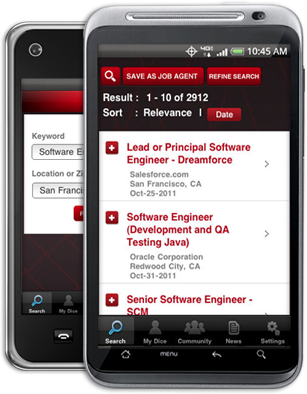 Mobile app development has moved in a big way into the enterprise—and the datacenter—in response to demand from mobile-device-toting information workers. Studies show that most organizations use some mobile apps; that more are planning to do so; and that, in a few years, it will be unusual to find a commercial or homegrown enterprise business application that doesn’t have a functioning client for smartphones and tablets. That doesn't mean building and deploying such software will be easy or cheap, especially for the corporate application-development teams actually responsible for the apps, which run on some of the least-secure devices available while interacting with data stored in some of the most-protected datacenter storage networks. More than two thirds of businesses utilize some business apps on mobile devices, according to a new Yankee Group study that also found use of mobile customer resource management and sales-force automation had tripled during the past five years. That rate of growth is pokey compared to what's coming, according to research firm Gartner, which predicted the number of mobile versions of CRM clients would leap 1,200 percent by the end of 2014. By 2015, 60 percent of knowledge workers will use corporate apps focused on content—rather than transactions, for example. Building apps isn't cheap, however. One out of four large companies spends more than $100,000 to build a single enterprise-class mobile app, but not because of the portion of it that actually runs on a mobile device, according to a report on mobile development released by AnyNet, which offers cloud-based middleware and data-integration services for mobile apps. More than half the companies surveyed by AnyNet reported taking at least three months to develop a mobile application, and a third said they release updates to each app at least once per month. Three quarters expect their companies to add three new mobile apps this year; 38 percent expect to launch six. But there's very little consistency to the way they do it. Custom development—the gold standard for integration with legacy systems—is going out of style. Only 28 percent of companies AnyNet polled do all their dev work without commercial development tools, though 23 percent expect to be “all custom” in 12 months. Forty-five percent use mobile development platforms or frameworks such as Appcelerator's Titanium or Adobe PhoneGap, which are designed to automate some of the process, provide easy access to both plugins and to the APIs and integration modules used to connect to back-end corporate data and to cloud services. Dev tools don't produce the most efficient code, can compile and run more slowly than custom-written code, and restrict developers' options, according to a review of cross-platform mobile dev tools from TechRepublic. There is also little standardization in either the tools or the platforms. The long list of mobile frameworks maintained by developer Markus Falk is far more complicated than a similar comparison of PC app dev tools, because there are almost a dozen OSes on which they can be tuned to run, an equal number of development languages to choose among, and a hopelessly complex mesh of hardware functions such as accelometers, geolocation, compasses and others that that may or may not be in any particular BYOD smartphone. Most mobile corporate apps also have to be developed for both iOS and Android, the designers of which are so competitive. "The animosity that exists at Apple towards Android is somehow translated through the platform’s language," according to TechRepublic. The only reasonable way to handle the diversity and speed with which hardware and operating systems change (along with the evolution in form factors) is to limit the options to be supported and give up on the idea of standardization of user interfaces, device-specific functions and other variations, according to a mobile-device management presentation from Gartner analysts Phil Redman and Bryan Taylor. Any mobile development effort will involve the need to "manage diversity" of software and hardware, which means limiting the type of device and/or operating system, and do a detailed analysis to decide if the backend is best run in the cloud as a service or inside the datacenter. Right now 52 percent of companies polled by AnyPresence run the server-side components of the apps within their own datacenters; 44 percent use a private cloud, while 38 percent use public clouds for at least some apps. But managing users is as important as managing architecture. Just as with UI-intensive application development, it's best to bring end users into the process to some degree and to schedule three to four months to negotiate the range of devices to be supported, and to make adjustments to the app to compensate for the problems that users encounter in the real world. It's also important to get the whole application-development process tuned for faster deliver and more complexity, according to Gartner analyst Whit Andrews. Users will continue to expect more and better access from mobile corporate apps, including full access to documents in content-management systems and video as well. By 2014, 60 percent of information workers will access content-heavy applications on mobile devices and 90 percent of companies will support applications that run on a variety of devices, not just PCs or laptops and one or two models of smartphone. Failing to meet increasingly complex expectations from users will be even more expensive than developing a mobile app with support for many clients in the first place, Andrews told BroadwayWorld. Just as with traditional corporate client/server apps, custom-written or heavily modified corporate apps can turn out to be a waste of time if developers don't handle users' choice of hardware the right way, or build UIs that let users work quickly, use a minimum of keyboard strokes and get to the data in a speedy manner. "By the end of 2016, we expect 50 percent of content and collaboration initiatives will fail because of low levels of engagement from the users for whom they were built," Andrews said. Image: graphit/Shutterstock.com
Mobile app development has moved in a big way into the enterprise—and the datacenter—in response to demand from mobile-device-toting information workers. Studies show that most organizations use some mobile apps; that more are planning to do so; and that, in a few years, it will be unusual to find a commercial or homegrown enterprise business application that doesn’t have a functioning client for smartphones and tablets. That doesn't mean building and deploying such software will be easy or cheap, especially for the corporate application-development teams actually responsible for the apps, which run on some of the least-secure devices available while interacting with data stored in some of the most-protected datacenter storage networks. More than two thirds of businesses utilize some business apps on mobile devices, according to a new Yankee Group study that also found use of mobile customer resource management and sales-force automation had tripled during the past five years. That rate of growth is pokey compared to what's coming, according to research firm Gartner, which predicted the number of mobile versions of CRM clients would leap 1,200 percent by the end of 2014. By 2015, 60 percent of knowledge workers will use corporate apps focused on content—rather than transactions, for example. Building apps isn't cheap, however. One out of four large companies spends more than $100,000 to build a single enterprise-class mobile app, but not because of the portion of it that actually runs on a mobile device, according to a report on mobile development released by AnyNet, which offers cloud-based middleware and data-integration services for mobile apps. More than half the companies surveyed by AnyNet reported taking at least three months to develop a mobile application, and a third said they release updates to each app at least once per month. Three quarters expect their companies to add three new mobile apps this year; 38 percent expect to launch six. But there's very little consistency to the way they do it. Custom development—the gold standard for integration with legacy systems—is going out of style. Only 28 percent of companies AnyNet polled do all their dev work without commercial development tools, though 23 percent expect to be “all custom” in 12 months. Forty-five percent use mobile development platforms or frameworks such as Appcelerator's Titanium or Adobe PhoneGap, which are designed to automate some of the process, provide easy access to both plugins and to the APIs and integration modules used to connect to back-end corporate data and to cloud services. Dev tools don't produce the most efficient code, can compile and run more slowly than custom-written code, and restrict developers' options, according to a review of cross-platform mobile dev tools from TechRepublic. There is also little standardization in either the tools or the platforms. The long list of mobile frameworks maintained by developer Markus Falk is far more complicated than a similar comparison of PC app dev tools, because there are almost a dozen OSes on which they can be tuned to run, an equal number of development languages to choose among, and a hopelessly complex mesh of hardware functions such as accelometers, geolocation, compasses and others that that may or may not be in any particular BYOD smartphone. Most mobile corporate apps also have to be developed for both iOS and Android, the designers of which are so competitive. "The animosity that exists at Apple towards Android is somehow translated through the platform’s language," according to TechRepublic. The only reasonable way to handle the diversity and speed with which hardware and operating systems change (along with the evolution in form factors) is to limit the options to be supported and give up on the idea of standardization of user interfaces, device-specific functions and other variations, according to a mobile-device management presentation from Gartner analysts Phil Redman and Bryan Taylor. Any mobile development effort will involve the need to "manage diversity" of software and hardware, which means limiting the type of device and/or operating system, and do a detailed analysis to decide if the backend is best run in the cloud as a service or inside the datacenter. Right now 52 percent of companies polled by AnyPresence run the server-side components of the apps within their own datacenters; 44 percent use a private cloud, while 38 percent use public clouds for at least some apps. But managing users is as important as managing architecture. Just as with UI-intensive application development, it's best to bring end users into the process to some degree and to schedule three to four months to negotiate the range of devices to be supported, and to make adjustments to the app to compensate for the problems that users encounter in the real world. It's also important to get the whole application-development process tuned for faster deliver and more complexity, according to Gartner analyst Whit Andrews. Users will continue to expect more and better access from mobile corporate apps, including full access to documents in content-management systems and video as well. By 2014, 60 percent of information workers will access content-heavy applications on mobile devices and 90 percent of companies will support applications that run on a variety of devices, not just PCs or laptops and one or two models of smartphone. Failing to meet increasingly complex expectations from users will be even more expensive than developing a mobile app with support for many clients in the first place, Andrews told BroadwayWorld. Just as with traditional corporate client/server apps, custom-written or heavily modified corporate apps can turn out to be a waste of time if developers don't handle users' choice of hardware the right way, or build UIs that let users work quickly, use a minimum of keyboard strokes and get to the data in a speedy manner. "By the end of 2016, we expect 50 percent of content and collaboration initiatives will fail because of low levels of engagement from the users for whom they were built," Andrews said. Image: graphit/Shutterstock.com How Mobile Apps Torture Business Developers
 Mobile app development has moved in a big way into the enterprise—and the datacenter—in response to demand from mobile-device-toting information workers. Studies show that most organizations use some mobile apps; that more are planning to do so; and that, in a few years, it will be unusual to find a commercial or homegrown enterprise business application that doesn’t have a functioning client for smartphones and tablets. That doesn't mean building and deploying such software will be easy or cheap, especially for the corporate application-development teams actually responsible for the apps, which run on some of the least-secure devices available while interacting with data stored in some of the most-protected datacenter storage networks. More than two thirds of businesses utilize some business apps on mobile devices, according to a new Yankee Group study that also found use of mobile customer resource management and sales-force automation had tripled during the past five years. That rate of growth is pokey compared to what's coming, according to research firm Gartner, which predicted the number of mobile versions of CRM clients would leap 1,200 percent by the end of 2014. By 2015, 60 percent of knowledge workers will use corporate apps focused on content—rather than transactions, for example. Building apps isn't cheap, however. One out of four large companies spends more than $100,000 to build a single enterprise-class mobile app, but not because of the portion of it that actually runs on a mobile device, according to a report on mobile development released by AnyNet, which offers cloud-based middleware and data-integration services for mobile apps. More than half the companies surveyed by AnyNet reported taking at least three months to develop a mobile application, and a third said they release updates to each app at least once per month. Three quarters expect their companies to add three new mobile apps this year; 38 percent expect to launch six. But there's very little consistency to the way they do it. Custom development—the gold standard for integration with legacy systems—is going out of style. Only 28 percent of companies AnyNet polled do all their dev work without commercial development tools, though 23 percent expect to be “all custom” in 12 months. Forty-five percent use mobile development platforms or frameworks such as Appcelerator's Titanium or Adobe PhoneGap, which are designed to automate some of the process, provide easy access to both plugins and to the APIs and integration modules used to connect to back-end corporate data and to cloud services. Dev tools don't produce the most efficient code, can compile and run more slowly than custom-written code, and restrict developers' options, according to a review of cross-platform mobile dev tools from TechRepublic. There is also little standardization in either the tools or the platforms. The long list of mobile frameworks maintained by developer Markus Falk is far more complicated than a similar comparison of PC app dev tools, because there are almost a dozen OSes on which they can be tuned to run, an equal number of development languages to choose among, and a hopelessly complex mesh of hardware functions such as accelometers, geolocation, compasses and others that that may or may not be in any particular BYOD smartphone. Most mobile corporate apps also have to be developed for both iOS and Android, the designers of which are so competitive. "The animosity that exists at Apple towards Android is somehow translated through the platform’s language," according to TechRepublic. The only reasonable way to handle the diversity and speed with which hardware and operating systems change (along with the evolution in form factors) is to limit the options to be supported and give up on the idea of standardization of user interfaces, device-specific functions and other variations, according to a mobile-device management presentation from Gartner analysts Phil Redman and Bryan Taylor. Any mobile development effort will involve the need to "manage diversity" of software and hardware, which means limiting the type of device and/or operating system, and do a detailed analysis to decide if the backend is best run in the cloud as a service or inside the datacenter. Right now 52 percent of companies polled by AnyPresence run the server-side components of the apps within their own datacenters; 44 percent use a private cloud, while 38 percent use public clouds for at least some apps. But managing users is as important as managing architecture. Just as with UI-intensive application development, it's best to bring end users into the process to some degree and to schedule three to four months to negotiate the range of devices to be supported, and to make adjustments to the app to compensate for the problems that users encounter in the real world. It's also important to get the whole application-development process tuned for faster deliver and more complexity, according to Gartner analyst Whit Andrews. Users will continue to expect more and better access from mobile corporate apps, including full access to documents in content-management systems and video as well. By 2014, 60 percent of information workers will access content-heavy applications on mobile devices and 90 percent of companies will support applications that run on a variety of devices, not just PCs or laptops and one or two models of smartphone. Failing to meet increasingly complex expectations from users will be even more expensive than developing a mobile app with support for many clients in the first place, Andrews told BroadwayWorld. Just as with traditional corporate client/server apps, custom-written or heavily modified corporate apps can turn out to be a waste of time if developers don't handle users' choice of hardware the right way, or build UIs that let users work quickly, use a minimum of keyboard strokes and get to the data in a speedy manner. "By the end of 2016, we expect 50 percent of content and collaboration initiatives will fail because of low levels of engagement from the users for whom they were built," Andrews said. Image: graphit/Shutterstock.com
Mobile app development has moved in a big way into the enterprise—and the datacenter—in response to demand from mobile-device-toting information workers. Studies show that most organizations use some mobile apps; that more are planning to do so; and that, in a few years, it will be unusual to find a commercial or homegrown enterprise business application that doesn’t have a functioning client for smartphones and tablets. That doesn't mean building and deploying such software will be easy or cheap, especially for the corporate application-development teams actually responsible for the apps, which run on some of the least-secure devices available while interacting with data stored in some of the most-protected datacenter storage networks. More than two thirds of businesses utilize some business apps on mobile devices, according to a new Yankee Group study that also found use of mobile customer resource management and sales-force automation had tripled during the past five years. That rate of growth is pokey compared to what's coming, according to research firm Gartner, which predicted the number of mobile versions of CRM clients would leap 1,200 percent by the end of 2014. By 2015, 60 percent of knowledge workers will use corporate apps focused on content—rather than transactions, for example. Building apps isn't cheap, however. One out of four large companies spends more than $100,000 to build a single enterprise-class mobile app, but not because of the portion of it that actually runs on a mobile device, according to a report on mobile development released by AnyNet, which offers cloud-based middleware and data-integration services for mobile apps. More than half the companies surveyed by AnyNet reported taking at least three months to develop a mobile application, and a third said they release updates to each app at least once per month. Three quarters expect their companies to add three new mobile apps this year; 38 percent expect to launch six. But there's very little consistency to the way they do it. Custom development—the gold standard for integration with legacy systems—is going out of style. Only 28 percent of companies AnyNet polled do all their dev work without commercial development tools, though 23 percent expect to be “all custom” in 12 months. Forty-five percent use mobile development platforms or frameworks such as Appcelerator's Titanium or Adobe PhoneGap, which are designed to automate some of the process, provide easy access to both plugins and to the APIs and integration modules used to connect to back-end corporate data and to cloud services. Dev tools don't produce the most efficient code, can compile and run more slowly than custom-written code, and restrict developers' options, according to a review of cross-platform mobile dev tools from TechRepublic. There is also little standardization in either the tools or the platforms. The long list of mobile frameworks maintained by developer Markus Falk is far more complicated than a similar comparison of PC app dev tools, because there are almost a dozen OSes on which they can be tuned to run, an equal number of development languages to choose among, and a hopelessly complex mesh of hardware functions such as accelometers, geolocation, compasses and others that that may or may not be in any particular BYOD smartphone. Most mobile corporate apps also have to be developed for both iOS and Android, the designers of which are so competitive. "The animosity that exists at Apple towards Android is somehow translated through the platform’s language," according to TechRepublic. The only reasonable way to handle the diversity and speed with which hardware and operating systems change (along with the evolution in form factors) is to limit the options to be supported and give up on the idea of standardization of user interfaces, device-specific functions and other variations, according to a mobile-device management presentation from Gartner analysts Phil Redman and Bryan Taylor. Any mobile development effort will involve the need to "manage diversity" of software and hardware, which means limiting the type of device and/or operating system, and do a detailed analysis to decide if the backend is best run in the cloud as a service or inside the datacenter. Right now 52 percent of companies polled by AnyPresence run the server-side components of the apps within their own datacenters; 44 percent use a private cloud, while 38 percent use public clouds for at least some apps. But managing users is as important as managing architecture. Just as with UI-intensive application development, it's best to bring end users into the process to some degree and to schedule three to four months to negotiate the range of devices to be supported, and to make adjustments to the app to compensate for the problems that users encounter in the real world. It's also important to get the whole application-development process tuned for faster deliver and more complexity, according to Gartner analyst Whit Andrews. Users will continue to expect more and better access from mobile corporate apps, including full access to documents in content-management systems and video as well. By 2014, 60 percent of information workers will access content-heavy applications on mobile devices and 90 percent of companies will support applications that run on a variety of devices, not just PCs or laptops and one or two models of smartphone. Failing to meet increasingly complex expectations from users will be even more expensive than developing a mobile app with support for many clients in the first place, Andrews told BroadwayWorld. Just as with traditional corporate client/server apps, custom-written or heavily modified corporate apps can turn out to be a waste of time if developers don't handle users' choice of hardware the right way, or build UIs that let users work quickly, use a minimum of keyboard strokes and get to the data in a speedy manner. "By the end of 2016, we expect 50 percent of content and collaboration initiatives will fail because of low levels of engagement from the users for whom they were built," Andrews said. Image: graphit/Shutterstock.com 

